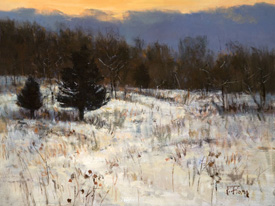
February Meadow
2007, oil/linen, 18x24
Private Collection
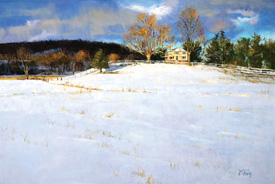
Winter Clearing
2007, oil/linen, 24x36
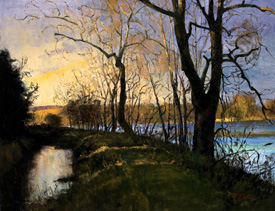
Autumn Sunset
2007, oil/linen, 24x30
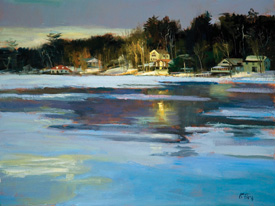
January Ice
2006, oil/linen, 18x24
Private Collection
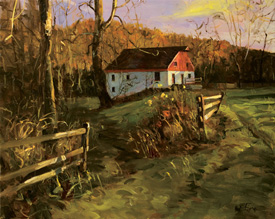
Barn at Bowman's Hill
2006, oil/linen, 24x30
Private Collection
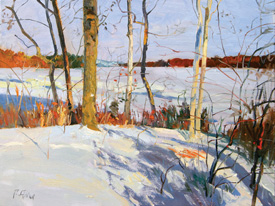
The Point, Late December
2004, oil/linen, 18x24
Private Collection
|
  |
American Artist Magazine
May 2008
Peter Fiore:
Freely Interpreting Nature
I think like a photographer,” states Peter Fiore, explaining how his boyhood passion for photography taught him to compose and see the world graphically. This lifelong interest was born by chance when his father, who managed a liquor store, traded a bottle for a camera. He gave his son the camera along with a promise to finance one roll of film and processing every week. The young Fiore soon carried his camera everywhere, read voraciously about photography, and within a year had progressed to setting up his own darkroom.
Today the first step in Fiore’s landscape-painting process begins with “a picture-hunting expedition.” While his wife drives, he observes, ready to jump out and take photos that are never random snapshots, he emphasizes. Instead, he studies the scene for a long time, figuring out what it is that attracts him. Then he carefully photographs all the elements of the landscape, not knowing which he might include in his painting or when a tree 300 yards away might end up in a finished work.
His camera is a 13-megapixel Canon 5D DSLR, which provides good details—good enough to produce 24"-x-36" prints of his artwork. The artist shoots raw files that he says are similar to digital film negatives. Using Photoshop as he would a darkroom, he changes exposure and temperature, but if he wants to drop that faraway tree into the scene, he does so in his initial oil studies, just as he would when painting from life. At one time Fiore printed out his reference photos in large format. Today he prefers to work from a 20-inch computer monitor, explaining that not only is the resolution crisper than in prints but it also allows him to see into the shadows. The color is also more reliable, too, although not as accurate as real life.
Although he feels comfortable using photographs to arrive at a landscape composition, Fiore still has some stern warnings against this practice. First, he says, it’s very rare to shoot a photo that’s perfect. He usually has to manipulate color and shape, and accentuate certain elements. Often he will take a photo of an undistinguished field and will then create studies, adding a dramatic sky above it or inventing cloud shapes to lead the viewer’s eye around the canvas. “A painting of a photograph is not a painting,” he explains. “Just because you have a good photograph doesn’t mean you have a good painting. It’s the same idea when you’re painting on location: just because you’re faithfully recreating the scene in front of you doesn’t necessarily mean it will turn out well. A painting is what I envision, not what nature gave me. I reorchestrate reality.” He goes on to say that students seem to want to include too much information in their work and that they need an editing process. He tells them to figure out what they’re responding to in a scene and make that the point of the painting, warning that if they include everything, they risk diluting the message.
In addition to using photographs, Fiore often makes on-site sketches, and because he can’t write as fast as he talks, he also uses a voice recorder to capture his verbal impressions of a scene. Back in his studio, with photos displayed on his computer monitor, he uses sketches to arrange the elements of the scene and figure out what direction he wants to take a painting. Next he paints studies—from 9" x 12" to 12" x 16"—using a large brush that allows him to get down the basics of shape, color, and value in 20 to 30 minutes. With this preliminary work done, it takes the artist only one day to bring the final painting—even one as large as 30" x 40"—to 90 percent completion.
Fiore begins a painting with a big bristle brush and a wash of color, to which he adds glazing medium and Gamblin Gamsol, and establishes the horizon line and large shapes. Because he’s less likely to make necessary changes if he’s afraid of losing the drawing underneath, he skips the drawing step. Painting as directly as possible, he tries to get the color, value, intensity, and quality of brushstrokes right the first time. One of Fiore’s painting secrets is squeezing out a lot of paint. “Paint must have dimension so you can move it, carve it,” he says. The final 10 percent of the process involves careful observation, after which he makes any necessary adjustments to edges and shapes, as well as completing those elements—such as bare trees against the sky—that are better done when the paint settles.
Once the painting is bone-dry, Fiore glazes, because he feels that glazing adds character and richness to the surface that can’t be achieved in any other way. He also uses glazes to modify—making areas warmer or cooler, darker or more neutral—to unify a painting, or to enrich it. The artist warns, however, that because glazing can sometimes make a painting look cheap, as if a sheet of cellophane were stretched over it, he uses the process sparingly. His preference for a glazing medium is Gamblin Galkyd Lite, to which he adds linseed oil when he wants to slow down the drying process. Fiore brushes it on vigorously, moving it around in a circular motion with the palm of his hand and wiping it away in areas he doesn’t want glazed. Then, to add variety, he scumbles back into certain sections—such as snowy fields—to create texture.
“Some people think you have to travel to find subjects to paint,” Fiore says, when asked where he finds inspiration for a landscape work, “but you just have to stand still and observe. Be patient, and it will come to you.” The artist lives in a rural area of Pennsylvania, and most of his subject matter is local. One stretch of nearby road inspired roughly 20 paintings in the past two years. Even an unexceptional field can be inspirational in the right light. That’s why the artist always brings a map and compass when he scouts locations, so he can come back to sketch and photograph when the light is most interesting. He is especially partial to the last 20 minutes of daylight when, even on a cloudy day, the landscape is often beautifully illuminated as the sun goes down. “The true subject of any painting is light,” he says. “If you have good light, anything can be made beautiful.”
About the Artist
Peter Fiore grew up in New Jersey and comes from a family of Sicilian craftsmen. He attended Pratt Institute, in New York City, with the intention of becoming a photojournalist but then decided to enroll in the illustration program. Half a semester short of receiving his degree, he left to pursue his illustration career, which was already in full swing. It wasn’t until he attended the Art Students League of New York, in Manhattan, however, that he learned to paint—until then he was producing what were essentially tinted drawings. An instructor at the League advised him to learn about color by buying a big box of pastels and experimenting. Besides teaching him about color, this also taught Fiore that, “ultimately you have to teach yourself and find a way to make pictures that are you,” he says. “I’m still learning how to paint after 34 years. That’s the great part: Art keeps you humble.” Fiore has been teaching at the School of Visual Arts, in New York City, for 17 years and has also taught at Syracuse University, in New York; University of Delaware, in Newark; and Pratt Institute. His is represented by Travis Gallery, in New Hope, Pennsylvania; Brazier Fine Art, in Richmond, Virginia; Kerygma, in Ridgewood, New Jersey; Cavalier Galleries, in Greenwich, Connecticut; and The Banks Gallery, in New London, New Hampshire.
Visit the American Artist Online Gallery.
--Linda Price for American Artist
________________________________________________
Linda Price is an artist, writer, and editor living on Long Island, New York.
________________________________________________
 More in Press More in Press
 About Peter About Peter
 Paintings Paintings
|